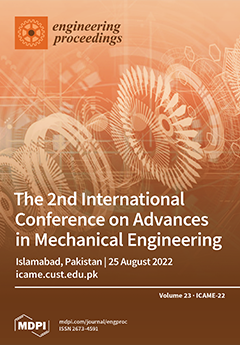Eng. Proc., 2022, ICAME-22
The 2nd International Conference on Advances in Mechanical Engineering
Islamabad, Pakistan | 25 August 2022
Volume Editors:
Muhammad Mahabat Khan, Capital University of Science and Technology (CUST), Pakistan
Mohammad Javed Hyder, Capital University of Science and Technology (CUST), Pakistan
Muhammad Irfan, Capital University of Science and Technology (CUST), Pakistan
Manzar Masud, Capital University of Science and Technology (CUST), Pakistan
Printed Edition Available!
- Issues are regarded as officially published after their release is announced to the table of contents alert mailing list.
- You may sign up for e-mail alerts to receive table of contents of newly released issues.
- PDF is the official format for papers published in both, html and pdf forms. To view the papers in pdf format, click on the "PDF Full-text" link, and use the free Adobe Reader to open them.




